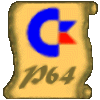Inside RRnet.txt: Difference between revisions
From ReplayResources
Jump to navigationJump to search
Count Zero (talk | contribs) (Created page with '<pre> This document is freely distributable as long as it is not changed, and one of the sources www.jschoenfeld.com, www.jschoenfeld.de, www.siliconsonic.com or www.ami.ga is me…') |
Count Zero (talk | contribs) mNo edit summary |
||
| Line 98: | Line 98: | ||
** EOF | ** EOF | ||
</pre> | </pre> | ||
[[Category:Ethernet Interfaces]] | |||
[[Category:Retro_Replay_Hardware]] | [[Category:Retro_Replay_Hardware]] | ||
[[Category:Retro_Replay_Software]] | [[Category:Retro_Replay_Software]] | ||
Revision as of 21:25, 6 June 2010
This document is freely distributable as long as it is not changed, and one
of the sources www.jschoenfeld.com, www.jschoenfeld.de, www.siliconsonic.com
or www.ami.ga is mentioned.
last update:
august 31st, 2003: initial release
General
-------
RR-Net is a 10MBit networking card that is designed for the commodore C64,
for use on the Retro Replay freezer cartridge. It'll also work on the Amiga
with a clock-port, but it is not recommended: The card does not support IRQs,
and it hardly fits mechanically. If you need network for your Amiga, use the
X-Surf 2 board.
Memory map
----------
The memory map depends on the place where RR-Net is connected. Although
RR-Net is designed for the C64, here are also the offset addresses for the
Amiga. Check the corresponding hardware documentations for the carrier cards
to obtain the base addresses of the clockport.
RR-Net is based on the Cirrus logic CS8900a (Crystal LAN). The chip is used
in 8-bit mode, so the 8 registers of an NE2000 are spread over 16 registers
in an 8-bit system. The 8-bit mode of the chip does not support IRQs (see
Cirrus logic application note AN181).
Do not forget to switch on the accessory connector of the Retro Replay by
setting bit 0 in $de01. See Inside_Replay.txt for more information.
C64 register Amiga register read/write meaning
none $00/$04 read-only interrupt status queue
$de02/$de03 $08/$0c read/write PackatPage pointer
$de04/$de05 $10/$14 read/write PacketPage Data (Port 0)
$de06/$de07 $18/$1c read/write PacketPage Data (Port 1)
$de08/$de09 $20/$24 read/write Receive/Transmit Data (Port 0)
$de0a/$de0b $28/$2c read/write Receive/Transmit Data (Port 1)
$de0c/$de0d $30/$34 write-only TxCMD (Transmit Command)
$de0e/$de0f $38/$3c write-only TxLength (Transmit Length)
Although the Amiga makes the interrupt status queue registers available, it
does not have any effect. Even if you try to activate the chip's IRQ features,
it will not have any effect. The IRQ line of the chip is not wired on RR-Net
at all!
If you compare this register map to the register map in AN181, you might
notice that the first and the second half of the register set is swapped.
This has been done, because the accessory connector of the Retro Replay does
not provide the full range of registers available on the Amiga clockport. The
first two bytes are control registers of the freezer cartridge, and this
swapping moves the unnecessary register-pair (IRQ status queue) into the
"invisible" area of the cartridge.
Endianess
---------
Although the chip is used in 8-bit mode, you have to know the endianess,
because each register pair forms a one 16-bit register. Ethernet is
big-endian by default. The chip was designed as an ISA thing, so all
registers appear as little endian. In other words: The lowbyte comes first,
then the highbyte.
MAC address
-----------
RR-Net does not have an EEprom to store the MAC address, so it should be
stored somewhere else: The flash rom of Retro Replay, the disk of the
Contiki operating system by Adam Dunkels (http://dunkels.com/adam/contiki/),
or Kickflash OS4 for the Amiga. The Mac address is only needed when
transmitting packets, so it's OK if it's loaded from mass storage media when
loading/starting the driver. The Mac address is NOT needed when RR-Net is
just connected to other networking equipment. The LINK led might already be
on, but the MAC address is only needed when something is transmitted into the
network.
More literature
---------------
Cirrus Logic Application note AN181: "Using the Crystal CS8900A in 8-bit
mode" by James Ayres: http://www.cirrus.com/en/pubs/appNote/an181.pdf
Crystal LAN CS8900A Ethernet Controller Technical Reference manual AN83:
http://www.cirrus.com/en/pubs/appNote/An83-3.pdf
The product data sheet for the CS8900A also contains software information,
starting at chapter 4 (page 38):
http://www.cirrus.com/en/pubs/proDatasheet/cs8900a-4.pdf
Application note 194: "How to program the Hash filter in the CS8900A":
http://www.cirrus.com/en/pubs/appNote/an194-1.pdf
The FAQ about the chip: http://www.cirrus.com/en/pubs/appNote/an205-2.pdf
Fine print
----------
RR-Net is not designed, authorized or warranted to be suitable for use in
life-support devices or systems or other critical operations. Inclusion of
the product in such applications is understood to be fully at the
customer's risk.
** EOF












